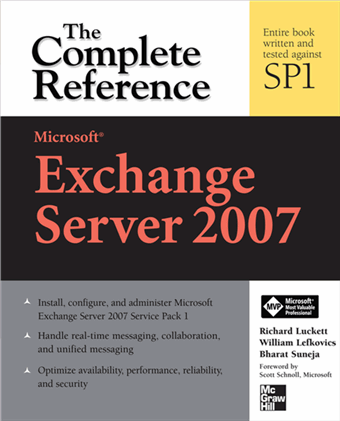Exchange Server 2007's Cluster Continuous Replication (CCR) clusters are not dependent on shared storage (when used with MNS quorum and a File Share Witness in Windows Server 2003). There are no protocol virtual server resources like SMTP, POP3, IMAP4, etc. — Exchange Server 2007's Clustered Mailbox Server (CMS) role is designed to be a Mailbox server. It cannot co-exist with any other Exchange 2007 server role.
This results in a greatly simplified cluster resource dependency model.
Note, Public Folder database support is available, with some limitations.
By default, the resources set up in a <CCR cluster:no shared disk resources in the above list!

Figure 1: Exchange Server 2007 resources in a CCR Cluster
This makes adding a new Storage Group to a CCR cluster easier. Generally you use a new set of volumes for the new Storage Group's transaction logs and mailbox Store, but there are no additional disk resources to add to the CMS in Cluster Administrator.
To add a new Storage Group:
1. In the Exchange console, create a new Storage Group
2. Add a new Mailbox Database to the Storage Group
That's it! Fire up cluster administrator and you'll see a new Microsoft Exchange Database Instance resource created for the new Storage Group, with the right dependencies.
Use the following command in Exchange shell to verify the new Storage Group is being replicated to the passive node.
This results in a greatly simplified cluster resource dependency model.
Note, Public Folder database support is available, with some limitations.
By default, the resources set up in a <CCR cluster:
- 1. IP Address
- 2. Network Name (depends on: IP Address resource)
- 3. Microsoft Exchange System Attendant (depends on: Network Name resource)
- 4. Microsoft Exchange Information Store (depends on: Network Name resource)
- 5. Microsoft Exchange Database Instance (depends on: Microsoft Exchange Information Store resource)

Figure 1: Exchange Server 2007 resources in a CCR Cluster
This makes adding a new Storage Group to a CCR cluster easier. Generally you use a new set of volumes for the new Storage Group's transaction logs and mailbox Store, but there are no additional disk resources to add to the CMS in Cluster Administrator.
To add a new Storage Group:
1. In the Exchange console, create a new Storage Group
2. Add a new Mailbox Database to the Storage Group
That's it! Fire up cluster administrator and you'll see a new Microsoft Exchange Database Instance resource created for the new Storage Group, with the right dependencies.
Use the following command in Exchange shell to verify the new Storage Group is being replicated to the passive node.
Get-StorageGroupCopyStatus "Second Storage Group" | Select SummaryCopyStatus,CCRTargetNode
Labels: Administration, Clustering, Exchange Server 2007

 Exchangepedia Blog is read by visitors from all 50 US States and 150 countries world-wide
Exchangepedia Blog is read by visitors from all 50 US States and 150 countries world-wide Demo:
Demo: 



0 Comments:
Post a Comment
Links to this post:
Create a Link
<< Home